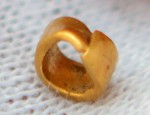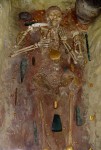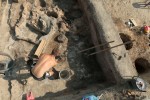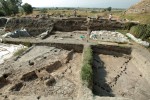 A tiny gold bead unearthed at a prehistoric site outside the town of Pazardzhik, southern Bulgaria, may be the oldest known gold artifact. It was discovered two weeks ago in the remains of a small house. The bead, a small strip of gold wrapped into a ring, weighs just 15 centigrams (.005 of an ounce) and is 4 millimeters (1/8 inch) in diameter. It dates to around 4600 B.C., although how that date was determined is not clear from the news reports.
A tiny gold bead unearthed at a prehistoric site outside the town of Pazardzhik, southern Bulgaria, may be the oldest known gold artifact. It was discovered two weeks ago in the remains of a small house. The bead, a small strip of gold wrapped into a ring, weighs just 15 centigrams (.005 of an ounce) and is 4 millimeters (1/8 inch) in diameter. It dates to around 4600 B.C., although how that date was determined is not clear from the news reports.
 The oldest known gold jewelry currently on the books was also found in Bulgaria, in the Copper Age necropolis at Varna. An enormous quantity of gold was found in burials and cenotaphs at the Varna necropolis, more than 3,000 artifacts weighing a total of six kilos. One grave alone, grave 43, held more gold than has ever been discovered from that period in the whole world combined. The Varna treasure dates to between 4600 and 4200 B.C., so there’s enough overlap that the Pazardzhik bead can’t be absolutely confirmed as the oldest with current dating technologies.
The oldest known gold jewelry currently on the books was also found in Bulgaria, in the Copper Age necropolis at Varna. An enormous quantity of gold was found in burials and cenotaphs at the Varna necropolis, more than 3,000 artifacts weighing a total of six kilos. One grave alone, grave 43, held more gold than has ever been discovered from that period in the whole world combined. The Varna treasure dates to between 4600 and 4200 B.C., so there’s enough overlap that the Pazardzhik bead can’t be absolutely confirmed as the oldest with current dating technologies.
Nonetheless, one archaeologist at least is certain the tiny bead predates the great treasure by at least 200 years.
“I have no doubt that it is older than the Varna gold,” Yavor Boyadzhiev, associated professor at the Bulgarian Academy of Science, said.
“It’s a really important discovery. It is a tiny piece of gold but big enough to find its place in history.”
The settlement in which the bead was found, known as Tell Yunatsite after a nearby village, is believed to have been founded by descendants of Anatolians who migrated to Europe from Asia Minor the 7th millennium B.C. and over the next thousand years developed metal processing know-how into a full-fledged industry. In the 5th millennium B.C., urban settlements grew around these burgeoning industrial centers. They are the oldest towns in Europe, and Tell Yunatsite may well be the oldest, with artifacts dating to 4900 B.C.
 So far archaeologists have unearthed between 10 and 12 hectares (25-30 acres) of the settlement, just about a third of the tell, and the remains of defensive wall that would have been about nine feet high when it still stood. Little of the homes and possible workplaces have survived, but there is evidence of specialization and larger-scale production, for instance seven millstones to grind grain were found in one room. There are streets, public buildings, closely-knit dwellings, even clearly discernible uptown and downtown neighborhoods.
So far archaeologists have unearthed between 10 and 12 hectares (25-30 acres) of the settlement, just about a third of the tell, and the remains of defensive wall that would have been about nine feet high when it still stood. Little of the homes and possible workplaces have survived, but there is evidence of specialization and larger-scale production, for instance seven millstones to grind grain were found in one room. There are streets, public buildings, closely-knit dwellings, even clearly discernible uptown and downtown neighborhoods.
 The settlement is known as the “Town of Birds” because of the more than 150 ceramic bird figurines unearthed at the site. The preponderance of the birds depicted sitting upright rather than in flight or other natural positions suggests the townspeople had a cultic devotion to their feathered friends. The Town of Birds was destroyed around 4100 B.C., probably by invading Indo-European tribes from the northeast. They did not have sophisticated urban culture, but they had horses and they had weapons and the defensive walls were not enough to keep them out. Skeletons of women, children and the elderly with holes inflicted by axes have been found strewn on the floors of structures, suggesting a deliberate massacre of non-combatant residents.
The settlement is known as the “Town of Birds” because of the more than 150 ceramic bird figurines unearthed at the site. The preponderance of the birds depicted sitting upright rather than in flight or other natural positions suggests the townspeople had a cultic devotion to their feathered friends. The Town of Birds was destroyed around 4100 B.C., probably by invading Indo-European tribes from the northeast. They did not have sophisticated urban culture, but they had horses and they had weapons and the defensive walls were not enough to keep them out. Skeletons of women, children and the elderly with holes inflicted by axes have been found strewn on the floors of structures, suggesting a deliberate massacre of non-combatant residents.
The bead will be studied now in order to confirm its age. Once the analysis is complete, it will be put on display at the Regional Historical Museum of Pazardzhik.
😎 – The Honorable Gentleman from no. 43 in ‘Varnenski Necropol’, with his 990 golden objects and altogether 1516 grams of gold, must have had subordinates to previously “collect” it from. All in all probably pretty much ‘business as usual’.
There are no figures for 4300BC, but Bulgaria ranks 69th -i.e. behind Turkey and ahead of Jamaica- in the Transparency International‘s World “Corruption Perception Index” (‘CPI’, in 2015: 41st, ’14: 43rd, ’13: 41st, ’12: 41st).
Turns out, the figures got ‘corruptly’ perceived :confused: :
The rank is 69th, but the figures for the previous years seem to be in fact scores instead of ranks.
In the photo of the skeleton, is that a gold cap might have been applied over the end of his *cough* penis?
Looks as if. Pre-dynastic Egypt calls them “sheaths.”
By the small size of that bead and the opinions above on what it was, I don’t think his wives and concubines would have been overly thrilled to have him join them in bed?
The age of these sites and signs of early literacy have astounded me since I first started reading about them decades ago. However, the heavy looting of archaeological sites in the region since the fall of Warsaw Pact makes it hard to get a real handle on context and dates.
History at a ‘glans’.. 😆 .. so to speak, in the ‘Town of Birds’. Furthermore, one might feel uneasy about what that older ring was used for.
What we know for sure, however, is that in Italy the golden glans cap and his kneecap would be perceived at the same hight.
“It dates to around 4600 B.C., although how that date was determined is not clear from the news reports.”
Of course. There’s no absolute dating of gold, only relative. So this is relatively oldest gold :p